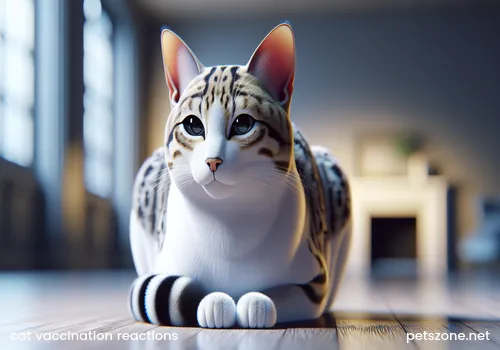Reactions After Cats Get Vaccinated_These Symptoms Should Not Be Ignored
Vaccinating cats is essentially putting a "golden shield" on them to resist viruses, but the process itself is not without disturbances. The majority of cats after vaccination do experience some minor “mood changes,” showing brief and mild discomfort, which is usually a normal response of the body building immunity and does not require excessive worry. However, as responsible "cat owners," we need to keep our eyes open to identify signals that may require vigilance, as life is no small matter.
We often say "vaccines are modern magic that saves lives," and this is true. The emergence of cat vaccines has greatly reduced the incidence of deadly infectious diseases such as feline panleukopenia, feline viral rhinotracheitis, and calicivirus, allowing countless cats to grow up healthily. Imagine, without vaccines, these viruses would be like invisible grim reapers, potentially taking away our beloved companions anytime. Therefore, despite some potential side effects, from a macro perspective, vaccinating cats remains a choice where benefits far outweigh the risks.

So, what specifically are these “minor mood changes” like?
First, and most commonly, is the so-called “nonspecific systemic reactions.” Simply put, cats may act as if they are a little sick but are not actually infected with the diseases targeted by the vaccine. It is similar to how we might feel soreness in our arm or a bit tired after some vaccines; it signals that the immune system is being activated and starting to work.
- Low energy or sleepiness: Usually lively cats may become quiet after the injection, spending most of their time sleeping and showing less interest in playing. This is common—they just need rest.
- Decreased appetite: Their appetite is not as good, or they simply show no interest in their favorite treats. Don’t worry, this usually resolves in a day or two.
- Mild fever: Their body feels a bit warm to the touch, and their temperature might be slightly higher than usual. This is a normal inflammatory response as the body fights the vaccine components.
- Injection site reactions: The injection site may be a bit swollen or painful; the cat might not want it touched or walk awkwardly. This is a local inflammation and is very common.
These mild reactions typically appear within 24-48 hours after vaccination and will subside on their own within one to three days. If your cat shows these symptoms, don’t panic; provide it with a quiet and comfortable environment, ensure plenty of water, and let it rest well.
However, things are not always so calm. Some symptoms, although less common, require serious attention and may even require immediate veterinary help. It’s like flying; most times it’s smooth and comfortable, but you should always know where the emergency exits are.
- Persistent gastrointestinal discomfort: If your cat has ongoing vomiting or diarrhea and the condition does not improve, this might not simply be a vaccine-induced stress response; other causes need to be ruled out.
- Severe lethargy or weakness: If the cat is not just sleepy but very weak, has difficulty standing, or is unresponsive to external stimuli, this could indicate a more serious problem.
- Allergic reactions: This is a more urgent condition usually occurring within minutes to hours after vaccination. Symptoms may include:
- Swelling of the face, mouth, nose, or eyelids, appearing puffy.
- Whole-body itching, incessant scratching, or hives (red, raised skin patches).
- Difficulty breathing, panting, persistent coughing.
- Collapse or shock, with the cat suddenly becoming very weak or even unable to stand.
These are signs of an immediate hypersensitivity reaction (Type I hypersensitivity), which is very rare but can be life-threatening (anaphylactic shock). Although incidence is very low (approximately 1 in 555,000 vaccinated cats in the UK data), once it occurs, the cat must be taken to the nearest animal hospital immediately. This is why many veterinarians recommend observing the cat for about 30 minutes at the clinic after the first vaccination before going home.
Besides these immediate or short-term reactions, there is a very rare but more concerning potential side effect called feline injection-site sarcoma (FISS). This malignant tumor occurs at the vaccination or other injection sites. This concept was recognized only in 1991 and was once called "vaccine-associated sarcoma" (VAS) because it was initially linked to inactivated vaccines (especially rabies and feline leukemia vaccines).
Although it is now generally believed that any injection can theoretically induce this sarcoma, including non-vaccine injections and even sutures, adjuvanted vaccines (especially those containing aluminum adjuvants) that cause stronger local inflammation are considered more closely related to a higher risk of FISS. Fortunately, the incidence of FISS is very low; U.S. statistics show about 1 to 4 cases per 10,000 vaccinated cats, with some studies suggesting it might be higher, up to 13 to 16 cases. Regardless, this remains a very rare event.
FISS is concerning because it is highly locally invasive, with a very high recurrence rate even after extensive surgical removal. Moreover, unlike allergic reactions, it cannot be immediately detected. Usually, FISS appears months or even years after vaccination.
So, how can we detect this “hidden enemy” early? The veterinary community commonly follows the “3-2-1 rule”:
- 3: A lump at the injection site persists for 3 months or more after vaccination.
- 2: The lump at the injection site is larger than 2 centimeters in diameter.
- 1: The lump at the injection site continues to grow within 1 month after vaccination.
If your cat develops any lump at the vaccination site that meets any of these criteria, be sure to take it to the veterinarian immediately for further examination, such as a biopsy, to determine the nature of the lump. Early detection, diagnosis, and treatment are essential for FISS.
To reduce the risk of FISS, some international organizations and veterinarians recommend the following strategies:
- Choose non-adjuvanted vaccines: If possible, prioritize non-adjuvanted vaccines designed specifically for cats, as adjuvants are believed to cause stronger inflammatory reactions and may increase the risk of FISS.
- Standardize injection sites: Instead of the traditional shoulder blade area, it is recommended to inject vaccines into the distal limbs (below the knee), outer abdomen, or base of the tail. The advantage is that if FISS occurs at these sites, large-scale surgical removal, including amputation or tail removal, is easier, improving treatment success. This is why professional veterinarians carefully record the exact injection site in medical records.
- Develop a reasonable immunization plan: Communicate fully with your veterinarian and make the most suitable vaccination schedule based on your cat’s living environment (indoor, outdoor, multi-cat household, etc.) and age. Reducing unnecessary vaccine doses (for example, some vaccines don’t require yearly boosters and can be given every three years or monitored via antibody titers) can also reduce overall injection risks.
Ultimately, vaccination is a decision weighing pros and cons. We cannot give up on protecting cats from deadly infectious diseases due to very low risk of side effects, but we also must not ignore potential risks. What we need to do is understand these risks, take effective preventive measures, and respond promptly and rationally if problems arise.
So next time you take your cat for vaccination, besides preparing some treats and a cat carrier, please remember these key points:
- Pre-communication: Discuss in detail with your veterinarian about vaccine types, vaccination schedule, and whether your cat has any history of allergies or other health issues.
- During vaccination observation: Follow your veterinarian’s advice and observe your cat at the clinic for some time after the injection.
- Post-care and monitoring: At home, provide a comfortable environment and closely monitor your cat’s energy, appetite, and the injection site condition. Most mild reactions are normal, but if symptoms are severe, prolonged, or there is an abnormal lump at the injection site, contact your veterinarian immediately. Do not self-diagnose or delay.
The health of cats is our shared goal. Through a scientific attitude and careful observation, we can better protect these furry little lives. May every cat enjoy a healthy and carefree life!


